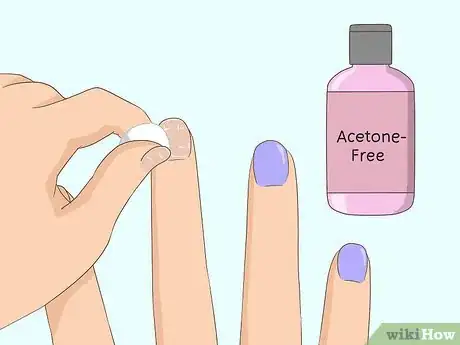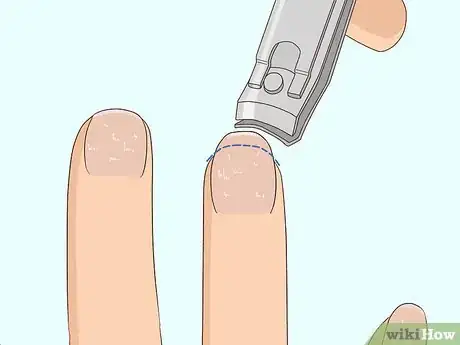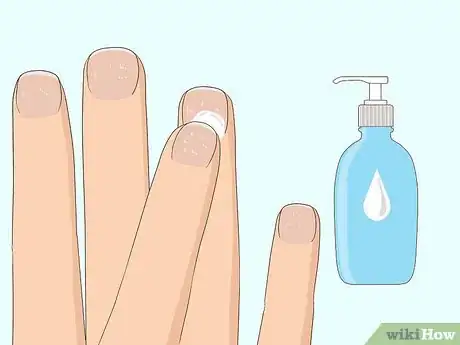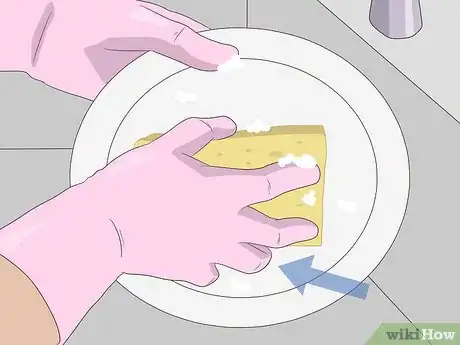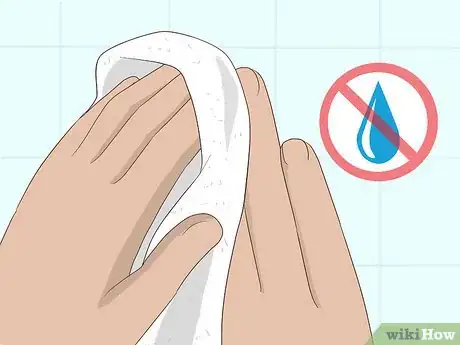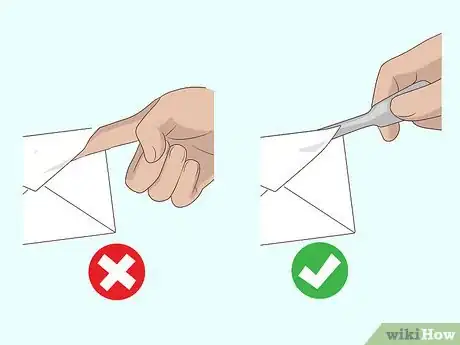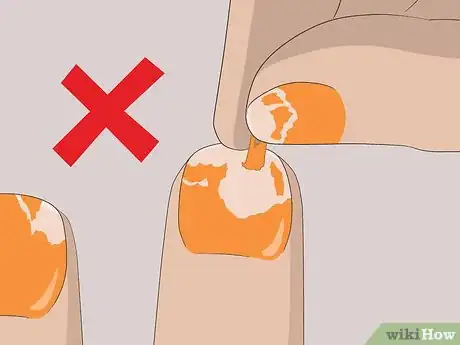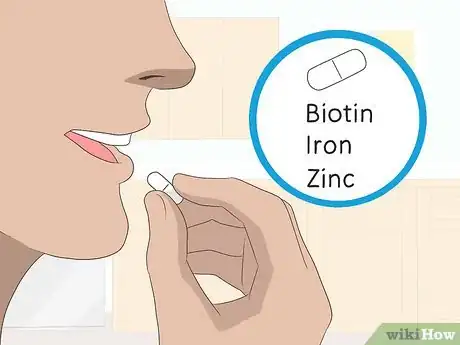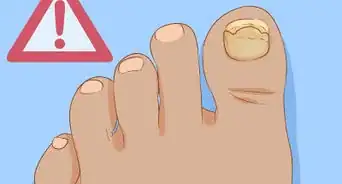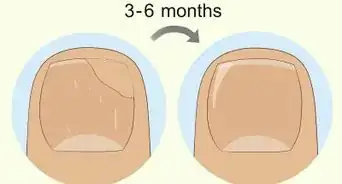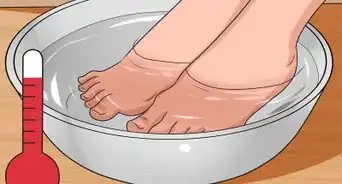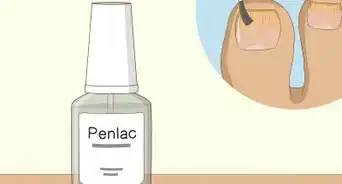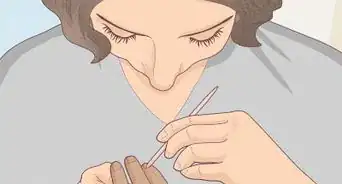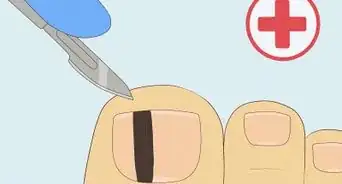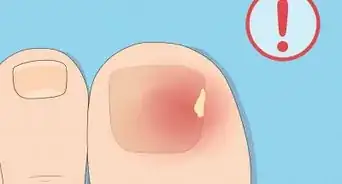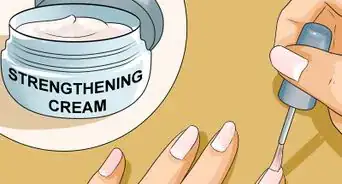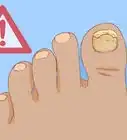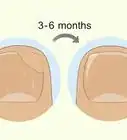This article was co-authored by Mia Rubie. Mia Rubie is a Nail Artist and the Owner of Sparkle San Francisco, a nail studio based in San Francisco, California. She has over eight years of nail artist and management experience and is known for her push-the-envelope designs and artistic eye for colors. Her clients include Sephora, Target, and Vogue. Her work has been featured in the San Francisco Chronicle and StyleCaster. She holds a BBA focusing on Entrepreneurial and Small Business Operations from San Francisco State University. You can find her work on her Instagram account @superflynails.
This article has been viewed 87,559 times.
Whether your peeling nails were caused by washing your hands too often, exposing your nails to chemicals, or the general wear-and-tear of polish and manicures, they can make you feel self-conscious. Luckily, there are a few simple things you can start doing to help heal your nails and prevent peeling in the future. Take a break from painting your nails or getting manicures for a while and focus on rehydrating those nail beds with oils and lotions. Take preventative measures, like wearing gloves when you clean, using things like letter-openers to open packages, and taking a supplement to help strengthen your nails.
Steps
Treating Peeling Nails
-
1Remove nail polish with an acetone-free nail polish remover. If you've noticed that your nails have been peeling, it's time to take a few weeks to help them heal before you apply more polish. In the meantime, get an acetone-free nail polish remover from your drugstore (acetone dries out your cuticles so it's best to avoid it), and use it to remove any polish currently on your nails.[1]
- Don't peel or chip nail polish. Doing so is really hard on your nails, and the act of peeling or chipping often strips away a layer of nail.
- Use cotton balls or swabs to apply the nail polish remover. Rub each nail gently until the polish comes off.
- If you currently have a gel or shellac manicure, you'll need to use acetone-based remover to get the polish off this time.
- Always follow up with a moisturizer after you remove nail polish. Even an acetone-free nail polish remover can dry out your nails.
-
2Trim your nails after showering to prevent them from splitting. In order to help your nails heal, you'll want to keep them short for a few weeks. After you shower, use a pair of nail clippers to trim your nails so that their edges are about even with the tips of your fingers. Repeat this once per week until your nails have stopped peeling.[2]
- Your nails will be softer after you take a hot shower or bath, making it the best time to clip them to keep them from breaking more.
- Make sure to use clean nail clippers. You can disinfect them before each use by washing them in warm water and dish detergent.
Advertisement -
3File your nails into a rounded shape to keep them from snagging. Position a nail file so that it's parallel to the side of your nail, and then move the file from the side toward the center. From the center, move the file down across the opposite side. Always file in the same direction (don't saw back and forth—that increases the chances of your nails breaking or peeling more). Keep filing until you've shaped your nail into a round shape, rather than square.[3]
- Always file your nails after cutting them to get rid of any rough edges.
- Use a fine grit nail file to create a smooth surface on your nail. If you also want to reduce the length of your nails, use a rougher grit to file down your nail before smoothing it out with a fine grit nail file.
-
4Massage a moisturizing oil into your nails and cuticles every day. There are lots of options for oil treatments. The best option is cuticle oil, which you can buy from a beauty supply store.[4] You can use natural oils that you may already have at home, like olive oil, coconut oil, or argan oil. Use an eyedropper to put 1 drop of oil onto each nail, then massage it into your nail bed.[5]
- The oil will moisturize your nails, which will make them less likely to peel.
-
5Apply hand moisturizer regularly to rehydrate your damaged nails. While you're working on treating your peeling nails, remember to keep your hands and nails hydrated. Use a moisturizing cream multiple times a day, especially after you've washed your hands.
- Start carrying lotion with you throughout the day so you can keep your nails moisturized even when you're on-the-go.
-
6Take a break from regular polish, acrylic tips, and gel manicures. You may be tempted to cover up your peeling nails with a fresh coat of polish, or maybe you just love doing your nails or getting them done at a salon. But take 2 to 3 weeks off from applying any kind of polish to your nails. Your nails need time to hydrate and heal, and polishes, tips, and gel manicures will slow down the healing process and potentially damage your nails more.[6]
- Once you do resume painting your nails again, remember to not peel away old polish.
Taking Preventative Measures
-
1Wear gloves to protect your nails when you clean and do chores. Too much water on your nails can dry them out, as can cleaning chemicals. The next time you wash dishes or clean your house, put on a pair of rubber gloves before you get started.
- This isn't just good for your nails—wearing rubber gloves also protects your hands from getting excessively dried out or irritated from cleaning products.
-
2Dry your hands completely any time they get wet. Although you might associate water with staying hydrated, it can actually deplete the moisture from your nails and skin. Don't let the water sit on your skin. Whenever you wash your hands or otherwise get them wet, use a clean towel to completely dry them off.
- Apply moisturizer afterwards to keep your hands and nails moist.
-
3Use something other than your nails to open packages. Don't scrape at labels, tape, or stickers, and avoid using your nails to open boxes, letters, and packages. Instead, use a letter-opener, box-cutter, or a pair of scissors to open packages.[7]
- Even opening soda cans with your nails can be harmful. Use your finger, a coin, or something else instead of your actual nail whenever you can.
-
4Resist chipping or peeling away your nail polish. When you do wear nail polish, don't peel or chip at old polish. Even if you notice it has started flaking off, resist the temptation to pull it away. This often peels off a layer of your nail as well as the polish. Instead, use an acetone-free remover to gently rub away old nail polish.[8]
- Especially if you have a shellac or gel manicure, you really don't want to peel it off. It can take months for your nails to recover from that kind of damage.
-
5Start taking a supplement like biotin, iron, or zinc. Biotin can make your nails stronger (and it also can be really great for hair growth), zinc may help if your nails have discolored areas, and iron can thicken nails that are on the thin side. Pick out one supplement to add to your daily regimen and stick with it for 3 to 4 months to see how your body responds.[9]
- You can also supplement your diet by eating more iron-rich foods, like spinach, legumes, red meat, and pumpkin seeds.
-
6Avoid over-buffing your nails while doing your nail-care routine. Buffing can remove layers of your nails, wipe away essential healthy oils, and possibly even catch on peeling sections. If and when you do buff your nails, buff each nail with only 6 to 8 strokes, and avoid pressing down hard on your nails.[10]
- Buffing can shape your nails and make them shiny, but if you're having trouble with peeling, you may want to skip this step for a few months until your nails are in better shape.
Expert Q&A
Did you know you can get expert answers for this article?
Unlock expert answers by supporting wikiHow
-
QuestionWhy do my nails get brittle and dry?
 Mia RubieMia Rubie is a Nail Artist and the Owner of Sparkle San Francisco, a nail studio based in San Francisco, California. She has over eight years of nail artist and management experience and is known for her push-the-envelope designs and artistic eye for colors. Her clients include Sephora, Target, and Vogue. Her work has been featured in the San Francisco Chronicle and StyleCaster. She holds a BBA focusing on Entrepreneurial and Small Business Operations from San Francisco State University. You can find her work on her Instagram account @superflynails.
Mia RubieMia Rubie is a Nail Artist and the Owner of Sparkle San Francisco, a nail studio based in San Francisco, California. She has over eight years of nail artist and management experience and is known for her push-the-envelope designs and artistic eye for colors. Her clients include Sephora, Target, and Vogue. Her work has been featured in the San Francisco Chronicle and StyleCaster. She holds a BBA focusing on Entrepreneurial and Small Business Operations from San Francisco State University. You can find her work on her Instagram account @superflynails.
Nail Artist This typically happens when people start picking or peeling their polish or acrylic nails. This removes a layer of your nail and cause them to dry out. So that may be one reason. The other possibility is that you're changing out your nails too often, which requires a lot of acetone. Acetone is extremely dehydrating and putting too much on your nails can dry them out.
This typically happens when people start picking or peeling their polish or acrylic nails. This removes a layer of your nail and cause them to dry out. So that may be one reason. The other possibility is that you're changing out your nails too often, which requires a lot of acetone. Acetone is extremely dehydrating and putting too much on your nails can dry them out.
Things You'll Need
Treating Peeling Nails
- Acetone-free nail polish remover
- Cotton balls
- Nail clippers
- Nail file
- Cuticle oil, or something similar
- Eyedropper
- Hand lotion
Taking Preventative Measures
- Gloves for cleaning
- Letter-opener or box-cutter
- Supplements like iron, zinc, or biotin (optional)
References
- ↑ https://youtu.be/CljwtOf8KPE?t=194
- ↑ https://www.marieclaire.co.uk/beauty/nails/stop-nails-splitting-peeling-416921
- ↑ Mia Rubie. Nail Artist. Expert Interview. 23 April 2020.
- ↑ Mia Rubie. Nail Artist. Expert Interview. 23 April 2020.
- ↑ https://youtu.be/CljwtOf8KPE?t=169
- ↑ https://fashionista.com/2014/10/peeling-nails
- ↑ https://www.medicalnewstoday.com/articles/322321.php
- ↑ Mia Rubie. Nail Artist. Expert Interview. 23 April 2020.
- ↑ https://www.medicalnewstoday.com/articles/322321.php
- ↑ Mia Rubie. Nail Artist. Expert Interview. 23 April 2020.
